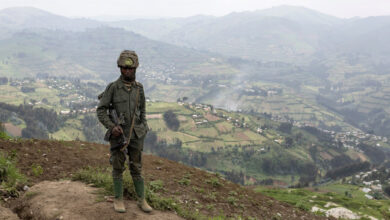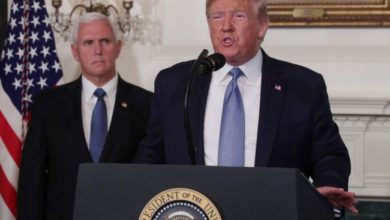International News
The true story behind Princess Diana’s fairytale wedding in ‘The Crown’
Charles and Diana's wedding was magical, but their public smiles and show of happiness masked secret tensions and concerns about their future together.

On July 29, 1981, Lady Diana Spencer walked down the aisle of Westminster Abbey, London, leading her wedding dress’ enormous train past 3,500 guests, including nobility, world dignitaries and royalty. Waiting for her at the altar was Prince Charles, Prince of Wales, eldest son and heir to Queen Elizabeth II.
Diana recalled feeling like “the luckiest girl in the world” to be marrying a man whom she loved so much, according to her biographer, Andrew Morton, in his book “Diana: Her True Story in Her Own Words” (Simon and Schuster, 1992). However, the happy day, which according to the BBC was witnessed by more than 750 million live television viewers around the world, masked the now-infamous and tragic reality of the couple’s relationship, marred by infidelity, loneliness and unrequited love.
How Charles and Diana met
When Charles celebrated his 30th birthday in November 1978, speculation about who would be his future wife quickly intensified. In 1977, he had been briefly involved in a relationship with Lady Sarah Spencer (now Lady Sarah McCorquodale), the vivacious eldest daughter of Earl Spencer. But that relationship lasted only a short while and fell apart when Sarah spoke to the press about Charles. However, before their relationship ended, Charles was invited to Althorp, the Spencer family’s home, and it was there that he met Sarah’s youngest sister, Lady Diana, who was just 16 years old and still at boarding school.
Charles was intrigued by Diana’s adolescent gaiety, later commenting he found her “very jolly and amusing.” The pair didn’t meet again until November 1978, when he invited her and Sarah to his 30th birthday party. Another 18 months passed before Charles and Diana started to become romantically involved, after Charles invited her to a party in July 1980, allegedly at the instigation of Camilla Parker Bowles, a married woman whom Charles had an on-again, off-again relationship with for several years.
In interview tapes recorded in 1992 and later released in the 2017 documentary “Diana: In Her Own Words,” Diana claimed that Charles “leapt” on her after she told him how it seemed to her that he needed someone to look after him. Charles, who had come to rather the same conclusion, could not help but respond to her sympathy.
Shortly afterward, Charles invited Diana to join him on the Royal Yacht Britannia and their relationship began moving very quickly. A month later, Charles invited Diana up to Balmoral Castle, the royal family’s Scottish home, which was taken as a strong sign that Charles was seriously interested in the young aristocrat.
Meeting the queen and the rest of the royal family on such an intimate level would be extremely daunting for most young women, especially one as shy and awkward as Diana was at that point, but her family had been connected with the royals for most of her life. In fact, Diana had been born in Park House on the Sandringham Estate, Queen Elizabeth II’s country home (Diana’s family lived there before her father inherited the Spencer earldom). And Diana’s formidable grandmother, Lady Fermoy, was one of the Queen Mother’s close friends.
The visit to Balmoral went well, with Diana charming everyone with her good nature and high spirits, and Charles took the next step of asking her to accompany him on a visit to Highgrove, his country house in Gloucestershire. Diana, who was used to the splendours of Althorp, found it a bit unimpressive and would have been even less thrilled if she had known that its primary attraction for Charles was its close proximity to Camilla’s house.
The engagement
In those 1992 tapes, Diana claimed that she met Charles only 13 times before they became engaged, but in reality they saw much more of each other, with several meetings in London as well as trips to the royal homes of Balmoral, Highgrove and Sandringham. She was also a guest at a small royal gathering for Charles’s 32nd birthday in November 1980. It was around that time that news of their relationship broke in the press and Diana began to be hounded by photographers, who followed her wherever she went, while the newspapers were rife with speculation that an engagement was imminent.
Charles’ much-expected proposal took place on Feb. 3, 1981 at Windsor Castle, with Diana allegedly being so overwhelmed that she thought Charles was joking and burst out laughing before saying yes. When Diana told Charles that she loved him, he replied “Whatever love is,” according to “Diana: Story of a Princess” (Simon and Schuster, 2001), by biographers Tim Clayton and Phil Craig. News of the engagement was kept secret for a few more weeks while Diana spent some time alone with her mother in Australia.
The royal engagement was officially announced on Feb. 24, 1981. In an interview with the BBC that day, Diana looked obviously besotted with her prince, but when asked if the couple were in love Charles again replied with “Whatever ‘in love’ means.” In her 1992 tapes, Diana referred to the interview as “ghastly,” and said that Charles’ response “threw me completely.”
Immediately after the announcement, Diana moved into Clarence House, the London home of the queen, as Diana’s flat in Chelsea, which she shared with a group of close female friends, was considered no longer suitable for a soon-to-be princess. According to Morton’s interviews, Diana said she packed her bags and left her flat with a police bodyguard, who warned her: “This is the last night of freedom ever in the rest of your life.”
Later, she moved up the road to Buckingham Palace, where she was given a relatively small suite of rooms on the nursery floor. This was a depressing experience for Diana, who quickly began to feel bored, lonely and isolated, according to Morton. She spent most of her time alone, as Charles was often away and his family paid her very little attention, assuming that she would quickly adapt to their ways and not realizing that she was in desperate need of guidance and support.
When Diana found out that Charles was planning a private farewell lunch with Camilla two days before the wedding, Diana became so upset that she threatened to call off the wedding. According to Morton, Diana’s sisters pointed out that it was far too late to cancel, they told her, because “your face is on the tea towels.”
Morton also wrote that it was during the months before her wedding that Diana first suffered from bulimia, as she grappled with the pressures of her new position and her unease about the relationship between her fiancé and Camilla.
Beyond the Palace gates, excitement about the forthcoming wedding was reaching fever pitch, with street parties planned all across the country. There was also a great deal of speculation about Diana’s wedding dress, which was being made by a young designer couple, David and Elizabeth Emanuel. According to Clayton and Craig, the dress required several fittings and adjustments due to Diana’s dramatic weight loss.
The wedding day
The wedding celebrations began two days before the big day with a final rehearsal in St. Paul’s Cathedral, which had been chosen as the wedding venue thanks to its enormous size and central London location. The rehearsal was followed by a huge ball held by the queen in Buckingham Palace, which Diana attended in a daring shocking pink, skin-tight Emanuel gown
Diana spent the night before her wedding at Clarence House with her sisters and bridal attendants, all of whom had to work hard to calm her nerves as she mentally prepared for her big day. Charles sent a gift of a signet ring across from Buckingham Palace, accompanied by a note telling her that “I am so proud of you and when you come up I’ll be there at the altar for you tomorrow. Just look ’em in the eye and knock them dead,” according to Penny Junor’s book “The Duchess: The Untold Story” (William Collins, 2017).
On the day of the wedding, Diana, accompanied by her father Earl Spencer, rode in the famous royal Glass coach to St. Paul’s Cathedral, cheered on by the vast crowds — an estimated 650,000 people — that lined the route from Clarence House.
For the crowds outside, the next glimpse of the newly married royal couple occurred shortly afterward when Charles and Diana made the traditional appearance on the Buckingham Palace balcony, flanked by their family and members of the wedding party. Charles had not sealed his wedding vows with a kiss but made up for this oversight by kissing Diana on the balcony, creating an iconic image that would feature on dozens of newspapers all around the globe the following day.
The wedding party enjoyed a lavish wedding breakfast of brill in lobster sauce followed by chicken stuffed with lamb mousse, with strawberries and cream for pudding. There were also no fewer than 27 wedding cakes, including the five-foot-tall (1.5 meter) official cake, which the couple cut after the ceremony.
In accordance with royal tradition, the couple did not stay for the evening party, but instead changed into their going-away outfits — in Diana’s case, a pretty peach Bellville Sassoon suit with matching hat — then bid their guests goodbye before climbing into the open landau carriage that took them to Waterloo Station. The groom’s mischievous younger brothers, Andrew and Edward, had secretly attached balloons, tin cans and a “Just Married” sign to the back of the carriage. This delighted the crowds that had gathered to watch the newlyweds leave for their honeymoon, which would involve a few days at Broadlands, Charles’ great uncle’s former country home in southeast England, followed by a Mediterranean cruise on the Royal Yacht Britannia and then several weeks alone on the Balmoral Estate.
By the time they returned from their honeymoon, Diana’s position as an international celebrity, on a scale that had almost certainly never been seen before, had been assured, thanks in part to the romantic magnificence of her wedding day. That the newly married Prince and Princess of Wales’ smiles masked her secret despair and his growing sense of unease about his marriage would not become apparent, to the public at least, for quite some time to come.
SOURCE: LIVE SCIENCE




